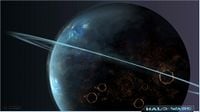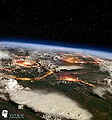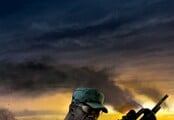Harvest: Difference between revisions
From Halopedia, the Halo wiki
No edit summary |
m (whoops.) |
||
| Line 21: | Line 21: | ||
}} | }} | ||
'''Harvest''' was a [[human]] [[Outer Colonies|Outer Colony]] world founded as a [[agriculture world|"breadbasket" world]]. Founded in [[2468]] by the {{UNSCShip|Skidbladnir}}, the colony was the most remote at the time of its founding.<ref>[http://halowars.com/GameInfo/Timeline.aspx '''Official Halo Wars Community Site''': ''Game Info - Timeline'']</ref><ref group="note" name="17th">According to ''Halo: Contact Harvest'', Harvest was the latest of humanity's seventeen colonies to be settled. The claim of humanity having a mere seventeen colony worlds has been ignored in later material, which instead appear to adhere to the more lenient figure of 800 worlds presented in the [[Xbox.com/Halo|original ''Halo'' timeline]]. Given that the timeline also states that | '''Harvest''' was a [[human]] [[Outer Colonies|Outer Colony]] world founded as a [[agriculture world|"breadbasket" world]]. Founded in [[2468]] by the {{UNSCShip|Skidbladnir}}, the colony was the most remote at the time of its founding.<ref>[http://halowars.com/GameInfo/Timeline.aspx '''Official Halo Wars Community Site''': ''Game Info - Timeline'']</ref><ref group="note" name="17th">According to ''Halo: Contact Harvest'', Harvest was the latest of humanity's seventeen colonies to be settled. The claim of humanity having a mere seventeen colony worlds has been ignored in later material, which instead appear to adhere to the more lenient figure of 800 worlds presented in the [[Xbox.com/Halo|original ''Halo'' timeline]]. Given that the timeline also states that 210 [[Inner Colonies]] had been settled before 2390, it is unlikely that the notion of Harvest being the seventeenth colony is considered canonical.</ref> Located in the [[Epsilon Indi system]],<ref>'''[[Halo: Contact Harvest]]''', ''page 32''</ref> the planet had the unfortunate distinction of being the first human planet discovered and destroyed by the [[Covenant]]. After [[First Battle of Harvest|a disastrous first contact]], the planet was subsequently [[glassing|glassed]] by the Covenant, but most of its population managed to escape in [[DCS light freighter|freighters]].<ref>'''Halo: Contact Harvest''', ''page 387''</ref> | ||
==History== | ==History== | ||
Revision as of 02:36, May 21, 2014
Harvest was a human Outer Colony world founded as a "breadbasket" world. Founded in 2468 by the UNSC Skidbladnir, the colony was the most remote at the time of its founding.[1][note 1] Located in the Epsilon Indi system,[2] the planet had the unfortunate distinction of being the first human planet discovered and destroyed by the Covenant. After a disastrous first contact, the planet was subsequently glassed by the Covenant, but most of its population managed to escape in freighters.[3]
History
The Forerunners
Harvest was known to the Forerunners approximately 100,000 years prior to the Human-Covenant War, and possessed at least one relic, a holographic stellar cartographer that pointed the way to another star system, Procyon. It is unknown whether the relic pointed to other Forerunner worlds and installations, or whether it was specifically built to guide users to a particular system.
Human colonization
Harvest was founded in 2468 when the UNSC Skidbladnir arrived transporting colonists, then dismantled to form the core of Utgard. One of the furthest and most isolated colonies to be founded by the UEG,[note 1] the population was still small when Sergeant Avery J. Johnson engaged in his first mission on the planet. By the time he returned in 2525, the population of Utgard alone had doubled. Most of the population of Harvest was of American descent, specifically the Midwestern states of the United States of America. Most locations on Harvest were named for elements of Norse mythology, as were its primary AIs, Sif and Loki; this is because many of Harvest's settlers were of Scandinavian ancestry.
UNSC breadbasket
In 2502, various secessionist and Insurrectionist groups were active on Harvest, including the People's Occupation Government, Harvest for Harvesters and the Secessionist Union, whose leader, Jerald Mulkey Ander, was assassinated by Avery Junior Johnson as part of the ORION Project's Operation KALEIDOSCOPE.[4]
Harvest was the first colony to be attacked by the Covenant and the first human world to be glassed. It was also the first place humanity officially made contact with the Covenant, after the incidents on This End Up and Minor Transgression.
In 2524, Staff Sergeant Johnson returned to Harvest along with Staff Sergeant Byrne and Captain Ponder, all survivors of Operation: TREBUCHET. They were to train a Colonial Militia and, unbeknownst to them, fend off what UNSC had believed to be Insurrectionist attacks on ships in the system.
On February 3, 2525, the Harvest orbital platform, the Tiara, made long-range radar and spectroscopic contact with Rapid Conversion. Contact with Harvest was lost thereafter.
Escape from Harvest

- Main article: First Battle of Harvest
The citizens of Harvest soon found themselves in the middle of the first battle between the Covenant and humanity, using their newly trained Militia to herd hundreds of thousands of civilian survivors from Gladsheim, Vigrond and other locations to the Utgard space elevators to escape the planet. During the first Covenant attack on Harvest about 250,000+ humans managed to escape the planet by packing into 236 freight containers which were then loaded into seven elevator depots in Utgard. Every five to seven minutes, seven pairs of freight containers were loaded into the space elevator. Loaded ahead of these freight containers were seven "grease buckets", maintenance containers, two which were loaded with Johnson's men and Jilan al-Cygni. The other five were decoys rigged with claymore mines which were used to soften the Brutes, Grunts and Drones which had boarded and taken control of Tiara.[5] While the other two "grease buckets" holding Johnson and Co. stopped and they were fighting off the Covenant, the number seven strand of the space elevator snapped a few thousand kilometers above its anchor due to the stress caused by the load becoming unbalanced. There were 11 pairs of freight containers on the strand when it snapped, killing around 20,000 people.[6] The remaining freight containers carrying the survivors of Harvest continued up the elevator, out into space, where they met up with propulsion pods that Sif had placed previously. Once Johnson and Co. finished fighting the Covenant on the Tiara, they joined the survivors and used the propulsion pods to enter Slipspace.[7]
At the time of these occurrences, the first prototypes of the Brute Chopper was made by a Huragok named Lighter Than Some. However, these were destroyed by JOTUNs commanded by the AI Mack.
After the destruction of the Tiara, the now rampant AI Mack buried its strands in a form of a funerary ritual for the AI Sif.
The discovery of humans on Harvest was the catalyst for the attempted Covenant genocide of the human race, due to a mistranslation of Forerunner glyphs by the Prophets, as seen on many writs and machines amid Covenant technologies.
The Battle of Harvest
By April 12th, 2525, the Colonial Military Administration sent the scout ship Argo to investigate. Other then confirming its arrival at Epsilon Indi no other transmissions were sent, and the Argo was presumed MIA.
On October 7th, 2525, Fleet Command assembled Battlegroup 4 to investigate, due to the fact that the Harvest situation was deemed to have become serious. The battle group consisted of the destroyer Heracles, commanded by Captain Veredi, as well as the frigates Arabia and Vostok. They entered the Harvest system only to find the planet's surface almost entirely melted down to glass. While there, the battle group encountered a Covenant super-destroyer. This vessel immediately fired on the inferior human vessels, and the Vostok and Arabia were lost with all hands. The Heracles managed to jump out of the system, but took several weeks to return to Reach due to damage sustained in the battle. Upon hearing Veredi's report and realizing the scale of the threat, the UNSC was placed on full alert and a fleet was assembled to meet the threat.[8]
Vice Admiral Preston J. Cole fought and barely won the Second Battle of Harvest in 2526. The UNSC was able to retake the planet but with the loss of 2/3 of their fleet, even when they had outnumbered the single Covenant ship in Harvest orbit.[9] Harvest would continue to be contested in the following years, as not long after, the Covenant attacked again. The battle for control of the planet lasted for five years until 2531, when Admiral Cole led a group of ships, including the UNSC Spirit of Fire into the system and neutralized the Covenant force. They later discovered that the Covenant had established a presence on the planet's surface, and more shockingly, had uncovered the previously unknown Forerunner relic which lead the Spirit to Arcadia[10] and later a Flood-controlled Shield World where they were able to stop a major Covenant threat.
Topography
Harvest was a small planet, approximately one-third the size of Earth with an equatorial diameter of slightly more than 4,000 kilometers (2,484 miles), making Harvest slightly smaller than the Sol planet Mercury.[11] In terms of surface area, Harvest possessed ~50 million km², roughly one-tenth the surface area of Earth. Harvest orbited Epsilon Indi extremely quickly, much faster than most other UNSC colonies, at roughly 150,000 km/h, or ~41km/sec (by comparison, Earth orbits Sol at roughly 30 km/sec). Harvest had no natural satellites. Harvest also has a day/night cycle only 17.5 Earth hours long. Out of a total of five planets in the Epsilon Indi system, Harvest was the only habitable planet, as well as being fertile for farming. The super-continent Edda dominated the planet, taking up roughly 67% of its surface. Two low-salinity seas covered the remainder of the planet, Hugin to the north, and Munin to the south.[12] Almost 86% of Edda is within 500 meters of sea level, the only major change in elevation is the Bifrost, an escarpment that "cuts" Edda in half.
Harvest's surface was once beautiful, covered in grassland and forests, lush fields and rolling hills, and a thousand lakes swarming with fish. The orchards were filled with luscious crops. At night, bats filled the skies.[13] After being glassed, however, the surface was reduced to a layer of melted glass, the destruction visible from orbit.[14] The environment suffered a catastrophic blow as a result, the once glorious landscape turning into a nearly frozen tundra, causing most species to quickly go extinct. Soon, all that remained of Harvest's original ecosystem were the scavengers, feeding off the rotting remains of the planet's once abundant wildlife, and even they perished before long.
Locations |
Ecology of Harvest |
Economy and society
Harvest was one of the Unified Earth Government's more productive and peaceful colonies. Within two decades of its founding, it had the highest per capita agricultural manufacture of any outer colony. Major crops, such as corn; wheat; watermelons; peaches; apples; grapes, and numerous other foodstuffs nourished the inhabitants of more than half a dozen other colonies.
By 2524 the population of Harvest was 300,000, most of whom escaped during the initial Covenant attack. The capital city and its largest population center was Utgard, also home to Harvest's seven space elevators connected to the orbital space station, Tiara.
The senior government official on Harvest was the Governor. The position was held by Nils Thune at the time of the planet's fall.[15] The Parliament of Harvest was also involved in the planet's governance. It met in a Parliament Building in Utgard.[16] One of its positions was the Attorney General, which was held by Rol Pedersen when the planet fell.
Harvest had its own planetary anthem and an official planetary introduction narrated by the agricultural operations AI Mack. This introduction was played to visitors traveling to the planet via the Tiara's space elevators.[17]
Gallery
- Harvest.png
Harvest, with frozen poles as a result of the "nuclear winter" effect caused by the Covenant's glassing.
Six of the seven space elevators linking the planet Harvest to the Tiara.
List of appearances
- Halo: The Fall of Reach (First appearance)
- Halo Graphic Novel
- Halo: Ghosts of Onyx (Mentioned only)
- Halo: Contact Harvest
- Halo Wars: Genesis (Mentioned only)
- Halo Wars
- Halo 3: ODST (Mentioned only)
- Halo Legends
- Halo: Evolutions - Essential Tales of the Halo Universe
- Halo: Reach (Mentioned only)
- Data pads (Mentioned only)
- Halo: Fall of Reach
- Halo 4: Forward Unto Dawn (Mentioned only)
- Halo 4 (Simulation only)
Note
- ^ a b According to Halo: Contact Harvest, Harvest was the latest of humanity's seventeen colonies to be settled. The claim of humanity having a mere seventeen colony worlds has been ignored in later material, which instead appear to adhere to the more lenient figure of 800 worlds presented in the original Halo timeline. Given that the timeline also states that 210 Inner Colonies had been settled before 2390, it is unlikely that the notion of Harvest being the seventeenth colony is considered canonical.
Sources
- ^ Official Halo Wars Community Site: Game Info - Timeline
- ^ Halo: Contact Harvest, page 32
- ^ Halo: Contact Harvest, page 387
- ^ Halo Graphic Novel, page 122
- ^ Halo: Contact Harvest, pages 351-352
- ^ Halo: Contact Harvest, page 372
- ^ Halo: Contact Harvest, page 352
- ^ Halo: The Fall of Reach, page ??
- ^ Halo Wars, Timeline
- ^ Halo Wars, campaign level, Relic Interior
- ^ Halo: Contact Harvest, page 33
- ^ Halo: Contact Harvest, page 74
- ^ Halo: Ghosts of Onyx, page 75
- ^ Halo: The Fall of Reach, page ??
- ^ Halo: Contact Harvest, page 115
- ^ Halo: Contact Harvest, page 79
- ^ Halo: Contact Harvest, pages 73-74



